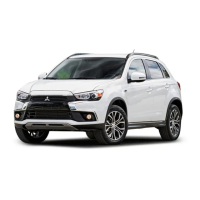Multi Around Monitor (if so equipped)
5-162 Features and controls
N00588000021
An overhead view in which the vehicle is
looked down is displayed so that you can eas-
ily identify the location of your vehicle and
the course to enter the parking space.
Bird’s eye-view mode
The bird’s eye-view is a composite image
from images captured by the “Front-view
camera”, “Side-view cameras (right and
left)” and “Rear-view camera”. As a result,
objects may appear to be farther away than
they actually are. Also, an object may appear
to be in a direction and/or location different
from actual. In addition, blind spots exist in
proximity of the vehicle.
Even if the screen indicates that there is a
space between your vehicle and an object,
there may actually be less or no space.
Always check visually behind and all around
your vehicle.
The view at a section near each corner on the
Bird's eye-view is combined from the edge
of the view captured by each camera. As
result, an object indicated in the section may
be unclear, and it may disappear/reappear on
the screen.
In the Bird’s eye-view mode, since the views
captured by the four cameras, “Front-view
camera”, “Side-view cameras (right and
left)” and “Rear-view camera” are processed
based on a level flat road surface, an image
may be displayed as follows:
• An object appears to have fallen down and
looks longer or larger.
• An object having a height from the road
surface may seem to appear from the joint
of the view composition processing
regions.
The brightness of the views from each cam-
era may vary depending on the illuminance
conditions.
An object above the camera is not displayed.
The object displayed in the Front-view mode
or the Rear-view mode may not be displayed
in the Bird’s eye-view mode.
The view in the Bird’s eye-view mode may
be displaced from its true position when the
mounting location and angle of each camera
are changed.
The lines on the road may appear to be dis-
placed or bent at the joint of the views.
BK0239700US.book 162 ページ 2016年6月16日 木曜日 午前10時58分

